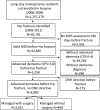Association of Clinical Outcomes With Surgical Repair of Hip Fracture vs Nonsurgical Management in Nursing Home Residents With Advanced Dementia
- PMID: 29801122
- PMCID: PMC5997966
- DOI: 10.1001/jamainternmed.2018.0743
Association of Clinical Outcomes With Surgical Repair of Hip Fracture vs Nonsurgical Management in Nursing Home Residents With Advanced Dementia
Abstract
Importance: The decision whether to surgically repair a hip fracture in nursing home (NH) residents with advanced dementia can be challenging.
Objective: To compare outcomes, including survival, among NH residents with advanced dementia and hip fracture according to whether they underwent surgical hip fracture repair.
Design, setting, and participants: We conducted a retrospective cohort study of 3083 NH residents with advanced dementia and hip fracture, but not enrolled in hospice care, using nationwide Medicare claims data linked with Minimum Data Set (MDS) assessments from January 1, 2008, through December 31, 2013.
Methods: Residents with advanced dementia were identified using the MDS. Medicare claims were used to identify hip fracture and to determine whether the fracture was managed surgically. Survival between surgical and nonsurgical residents was compared using multivariable Cox proportional hazards with inverse probability of treatment weighting (IPTW). All analyses took place between November 2015 and January 2018. Among 6-month survivors, documented pain, antipsychotic drug use, physical restraint use, pressure ulcers, and ambulatory status were compared between surgical and nonsurgical groups.
Results: Among 3083 residents with advanced dementia and hip fracture (mean age, 84.2 years; 79.2% female [n = 2441], 28.5% ambulatory [n = 879]), 2615 (84.8%) underwent surgical repair. By 6-month follow-up, 31.5% (n = 824) and 53.8% (n = 252) of surgically and nonsurgically managed residents died, respectively. After IPTW modeling, surgically managed residents were less likely to die than residents without surgery (adjusted hazard ratio [aHR], 0.88; 95% CI, 0.79-0.98). Among 2007 residents who survived 6 months, residents with surgical vs nonsurgical management had less docmented pain (29.0% [n = 465] vs 30.9% [n = 59]) and fewer pressure ulcers (11.2% [n = 200] vs 19.0% [n = 41]). In IPTW models, surgically managed residents reported less pain (aHR, 0.78; 95% CI, 0.61-0.99) and pressure ulcers (aHR, 0.64; 95% CI, 0.47-0.86). There was no difference between antipsychotic drug use and physical restraint use between the groups. Few survivors remained ambulatory (10.7% [n = 55] of surgically managed vs 4.8% [n = 1] without surgery).
Conclusions and relevance: Surgical repair of a hip fracture was associated with lower mortality among NH residents with advanced dementia and should be considered together with the residents' goals of care in management decisions. Pain and other adverse outcomes were common regardless of surgical management, suggesting the need for broad improvements in the quality of care provided to NH residents with advanced dementia and hip fracture.
Figures


Comment in
-
Hip Fractures in Patients With Advanced Dementia: What Treatment Provides the Best Palliation?JAMA Intern Med. 2018 Jun 1;178(6):780-781. doi: 10.1001/jamainternmed.2018.0822. JAMA Intern Med. 2018. PMID: 29801116 No abstract available.
References
-
- Rapp K, Becker C, Lamb SE, Icks A, Klenk J. Hip fractures in institutionalized elderly people: incidence rates and excess mortality. J Bone Miner Res. 2008;23(11):1825–1831. - PubMed
-
- Morris JN, Hawes C, Fries BE, et al. Designing the national resident assessment instrument for nursing homes. Gerontologist. 1990;30(3):293–307. - PubMed
Publication types
MeSH terms
Grants and funding
LinkOut - more resources
Full Text Sources
Other Literature Sources
Medical
Research Materials
Miscellaneous

